Berg J.M., Tymoczko J.L., Stryer L. Biochemistry
Подождите немного. Документ загружается.

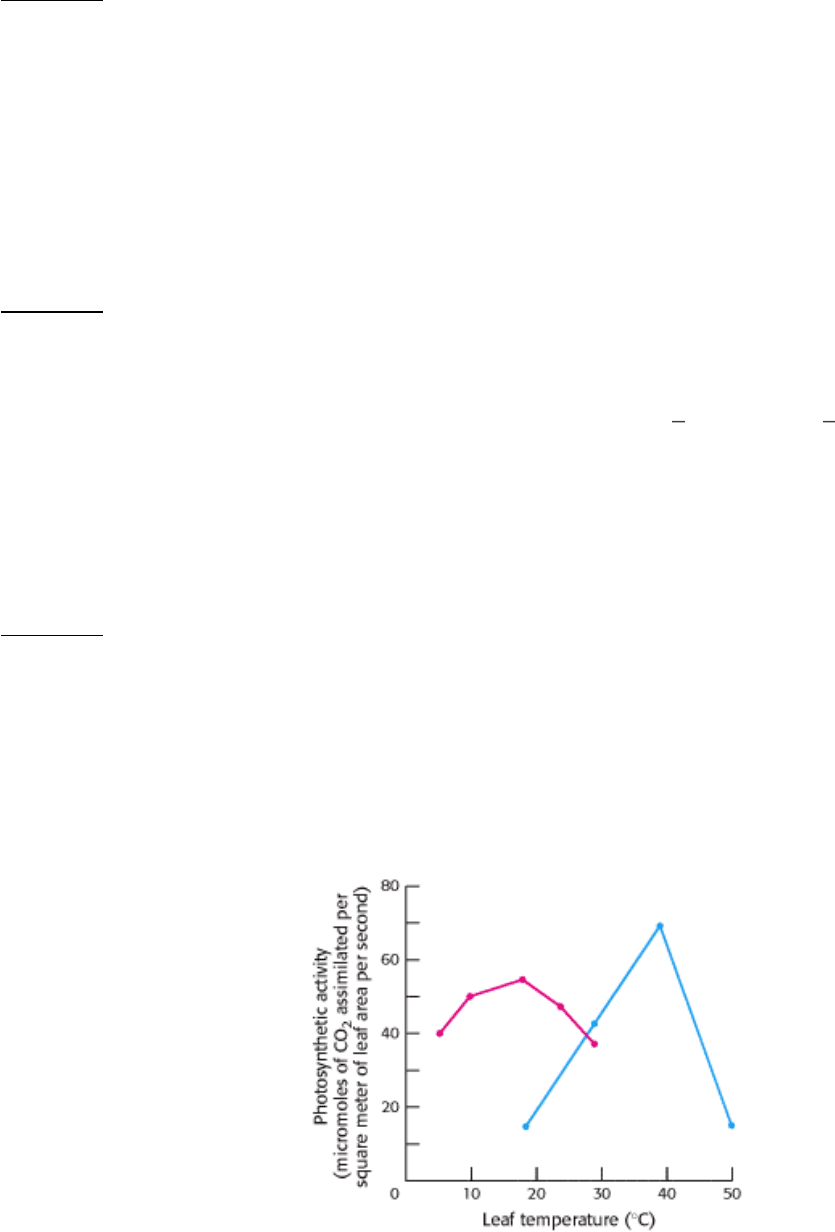
16.
A recurring intermediate. Phosphopentose isomerase interconverts the aldose ribose 5-phosphate and the ketose
ribulose 5-phosphate. Propose a mechanism.
See answer
Chapter Integration Problems
17.
Catching carbons. Radioactive-labeling experiments can yield estimates of how much glucose 6-phosphate is
metabolized by the pentose phosphate pathway and how much is metabolized by the combined action of glycolysis
and the citric acid cycle. Suppose that you have samples of two different tissues as well as two radioactively labeled
glucose samples, one with glucose labeled with
14
C at C-1 and the other with glucose labeled with
14
C at C-6.
Design an experiment that would enable you to determine the relative activity of the aerobic metabolism of glucose
compared with metabolism by the pentose phosphate pathway.
See answer
18.
Photosynthetic efficiency. Use the following information to estimate the efficiency of photosynthesis.
The ∆G°´ for the reduction of CO
2
to the level of hexose is +114 kcal mol
1
(+477 kJ mol
1
).
A mole of 600-nm photons has an energy content of 47.6 kcal (199 kJ).
Assume that the proton gradient generated in producing the required NADPH is sufficient to drive the synthesis of
the required ATP.
See answer
Date Interpretation Problem
19.
Graph A shows the photosynthetic activity of two species of plant, one a C
4
plant and the other a C
3
plant, as a
function of leaf temperature.
(A)
(a) Which data were most likely generated by the C
4
plant and which by the C
3
plant? Explain.
(b) Suggest some possible explanations for why the photosynthetic activity falls at higher temperatures.
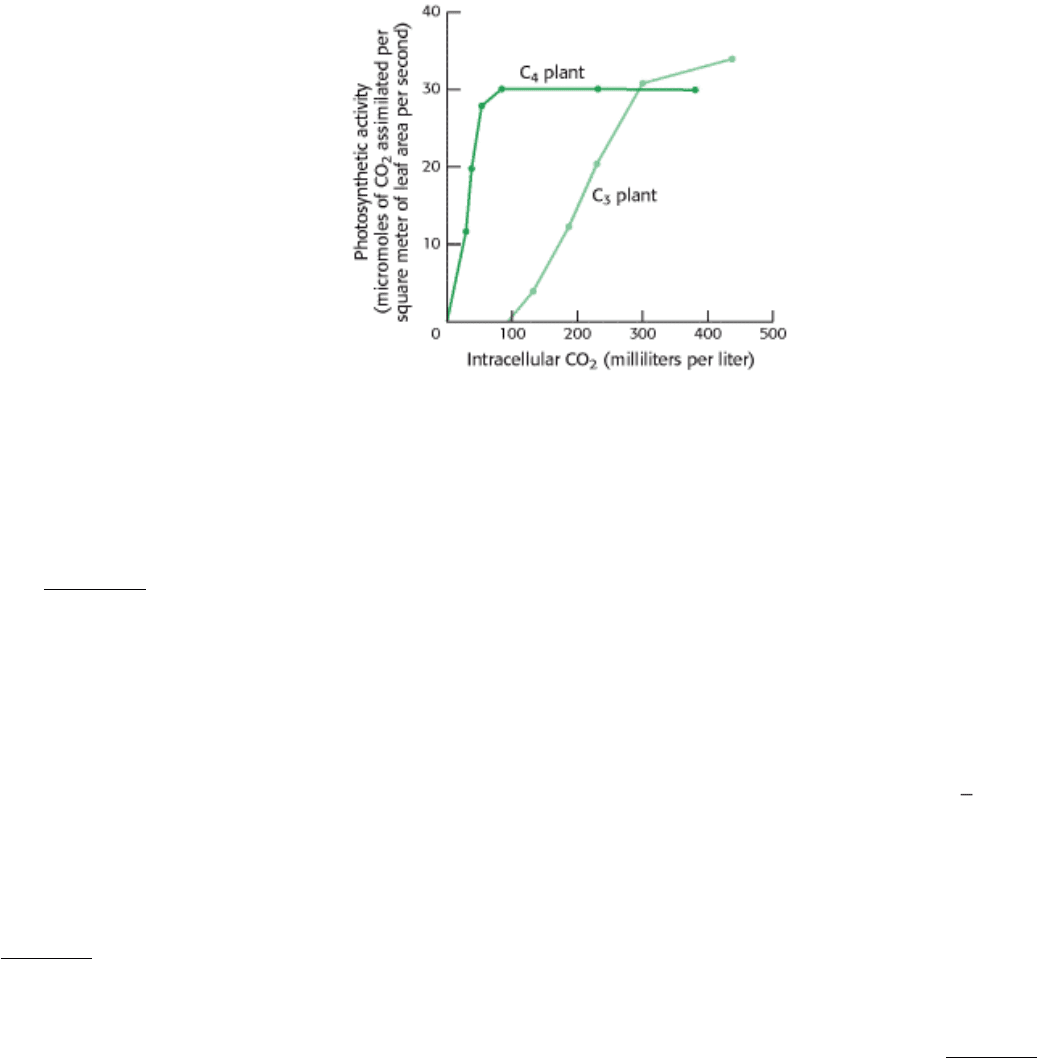
Graph B illustrates how the photosynthetic activity of C
3
and C
4
plants varies with CO
2
concentration when
temperature (30°C) and light intensity (high) are constant.
(B)
(c) Why can C
4
plants thrive at CO
2
concentrations that do not support the growth of C
3
plants?
(d) Suggest a plausible explanation for why C
3
plants continue to increase photosynthetic activity at higher CO
2
concentrations, whereas C
4
plants reach a plateau.
See answer
II. Transducing and Storing Energy 20. The Calvin Cycle and the Pentose Phosphate Pathway
Selected Readings
Where to start
Horecker, B. L., 1976.Unravelling the pentose phosphate pathway. In Reflections on Biochemistry (pp. 65
72), edited
by A. Kornberg, L. Cornudella, B. L. Horecker, and J. Oro, Pergamon.
Levi, P., 1984. Carbon. In The Periodic Table. Random House.
E. Melendez-Hevia and A. Isidoro. 1985. The game of the pentose phosphate cycle J. Theor. Biol. 117: 251-263.
(PubMed)
J. Barber and B. Andersson. 1994. Revealing the blueprint of photosynthesis Nature 370: 31-34.
S. Rawsthorne. 1992. Towards an understanding of C
3
-C
4
photosynthesis Essays Biochem. 27: 135-146. (PubMed)
Books and general reviews
Wood, T., 1985. The Pentose Phosphate Pathway. Academic Press.
Buchanan, B. B., Gruissem, W., and Jones, R. L., 2000. Biochemistry and Molecular Biology of Plants . American
Society of Plant Physiologists.
G. Schneider, Y. Lindqvist, and C. Branden. 1992. Rubisco: Structure and mechanism Annu. Rev. Biophys. Biomol.

Struct. 21: 119-143. (PubMed)
R.J. Spreitzer. 1993. Genetic dissection of rubisco structure and function Annu. Rev. Plant Physiol. Plant Mol. Biol. 44:
411-434.
Enzymes and reaction mechanisms
D.H. Harrison, J.A. Runquist, A. Holub, and H.M. Miziorko. 1998. The crystal structure of phosphoribulokinase from
Rhodobacter sphaeroides reveals a fold similar to that of adenylate kinase Biochemistry 37: 5074-5085. (PubMed)
H.M. Miziorko. 2000. Phosphoribulokinase: Current perspectives on the structure/function basis for regulation and
catalysis Adv. Enzymol. Relat. Areas Mol. Biol. 74: 95-127. (PubMed)
S. Thorell, P. Gergely Jr, K. Banki, A. Perl, and G. Schneider. 2000. The three-dimensional structure of human
transaldolase FEBS Lett. 475: 205-208. (PubMed)
Y. Lindqvist, G. Schneider, U. Ermler, and M. Sundstrom. 1992. Three-dimensional structure of transketolase, a
thiamine diphosphate dependent enzyme, at 2.5 Å resolution EMBO J. 11: 2373-2379. (PubMed)
B.H. Robinson and K. Chun. 1993. The relationships between transketolase, yeast pyruvate decarboxylase and pyruvate
dehydrogenase of the pyruvate dehydrogenase complex FEBS Lett. 328: 99-102. (PubMed)
Carbon dioxide fixation and rubisco
H. Sugawara, H. Yamamoto, N. Shibata, T. Inoue, S. Okada, C. Miyake, A. Yokota, and Y. Kai. 1999. Crystal structure
of carboxylase reaction-oriented ribulose 1,5-bisphosphate carboxylase/oxygenase from a thermophilic red alga,
Galdieria partita J. Biol. Chem. 274: 15655-15661. (PubMed)
S. Hansen, V.B. Vollan, E. Hough, and K. Andersen. 1999. The crystal structure of rubisco from Alcaligenes eutrophus
reveals a novel central eight-stranded beta-barrel formed by beta-strands from four subunits J. Mol. Biol. 288: 609-621.
(PubMed)
S. Knight, I. Andersson, and C.I. Branden. 1990. Crystallographic analysis of ribulose 1,5-bisphosphate carboxylase
from spinach at 2.4 Å resolution: Subunit interactions and active site J. Mol. Biol. 215: 113-160. (PubMed)
T.C. Taylor and I. Andersson. 1997. The structure of the complex between rubisco and its natural substrate ribulose 1,5-
bisphosphate J. Mol. Biol. 265: 432-444. (PubMed)
W.W. Cleland, T.J. Andrews, S. Gutteridge, F.C. Hartman, and G.H. Lorimer. 1998. Mechanism of rubisco: The
carbamate as general base Chem. Rev. 98: 549-561. (PubMed)
B.B. Buchanan. 1992. Carbon dioxide assimilation in oxygenic and anoxygenic photosynthesis Photosynth. Res. 33: 147-
162.
M.D. Hatch. 1987. C
4
photosynthesis: A unique blend of modified biochemistry, anatomy, and ultrastructure Biochim.
Biophys. Acta 895: 81-106.
Regulation
A. Rokka, L. Zhang, and E.-M. Aro. 2001. Rubisco activase: An enzyme with a temperature-dependent dual function?
Plant J. 25: 463-472. (PubMed)
N. Zhang and A.R. Portis Jr. 1999. Mechanism of light regulation of rubisco: A specific role for the larger rubisco
activase isoform involving reductive activation by thioredoxin-f Proc. Natl. Acad. Sci. USA 96: 9438-9443. (PubMed)
(Full Text in PMC)
N. Wedel, J. Soll, and B.K. Paap. 1997. CP12 provides a new mode of light regulation of Calvin cycle activity in higher

plants Proc. Natl. Acad. Sci. USA 94: 10479-10484. (PubMed) (Full Text in PMC)
L. Avilan, S. Lebreton, and B. Gontero. 2000. Thioredoxin activation of phosphoribulokinase in a bi-enzyme complex
from Chlamydomonas reinhardtii chloroplasts J. Biol. Chem. 275: 9447-9451. (PubMed)
V. Irihimovitch and M. Shapira. 2000. Glutathione redox potential modulated by reactive oxygen species regulates
translation of rubisco large subunit in the chloroplast J. Biol. Chem. 275: 16289-16295. (PubMed)
Glucose 6-phosphate dehydrogenase
S.W. Au, S. Gover, V.M. Lam, and M.J. Adams. 2000. Human glucose-6-phosphate dehydrogenase: The crystal
structure reveals a structural NADP(+) molecule and provides insights into enzyme deficiency Structure Fold. Des. 8:
293-303. (PubMed)
F. Salvemini, A. Franze, A. Iervolino, S. Filosa, S. Salzano, and M.V. Ursini. 1999. Enhanced glutathione levels and
oxidoresistance mediated by increased glucose-6-phosphate dehydrogenase expression J. Biol. Chem. 274: 2750-2757.
(PubMed)
W.N. Tian, L.D. Braunstein, K. Apse, J. Pang, M. Rose, X. Tian, and R.C. Stanton. 1999. Importance of glucose-6-
phosphate dehydrogenase activity in cell death Am. J. Physiol. 276: C1121-C1131. (PubMed)
W.N. Tian, L.D. Braunstein, J. Pang, K.M. Stuhlmeier, Q.C. Xi, X. Tian, and R.C. Stanton. 1998. Importance of glucose-
6-phosphate dehydrogenase activity for cell growth J. Biol. Chem. 273: 10609-10617. (PubMed)
M.V. Ursini, A. Parrella, G. Rosa, S. Salzano, and G. Martini. 1997. Enhanced expression of glucose-6-phosphate
dehydrogenase in human cells sustaining oxidative stress Biochem. J. 323: 801-806. (PubMed)
Evolution
J.F. Coy, S. Dubel, P. Kioschis, K. Thomas, G. Micklem, H. Delius, and A. Poustka. 1996. Molecular cloning of tissue-
specific transcripts of a transketolase-related gene: Implications for the evolution of new vertebrate genes Genomics 32:
309-316. (PubMed)
G. Schenk, R. Layfield, J.M. Candy, R.G. Duggleby, and P.F. Nixon. 1997. Molecular evolutionary analysis of the
thiamine-diphosphate-dependent enzyme, transketolase J. Mol. Evol. 44: 552-572. (PubMed)
R. Notaro, A. Afolayan, and L. Luzzatto. 2000. Human mutations in glucose 6-phosphate dehydrogenase reflect
evolutionary history FASEB J. 14: 485-494. (PubMed)
N. Wedel and J. Soll. 1998. Evolutionary conserved light regulation of Calvin cycle activity by NADPH-mediated
reversible phosphoribulokinase/CP12/glyceraldehyde-3-phosphate dehydrogenase complex dissociation Proc. Natl.
Acad. Sci. USA 95: 9699-9704. (PubMed) (Full Text in PMC)
W. Martin and C. Schnarrenberger. 1997. The evolution of the Calvin cycle from prokaryotic to eukaryotic
chromosomes: A case study of functional redundancy in ancient pathways through endosymbiosis Curr. Genet. 32: 1-18.
(PubMed)
M.S. Ku, Y. Kano-Murakami, and M. Matsuoka. 1996. Evolution and expression of C
4
photosynthesis genes Plant
Physiol. 111: 949-957. (PubMed) (Full Text in PMC)
J.G. Pereto, A.M. Velasco, A. Becerra, and A. Lazcano. 1999. Comparative biochemistry of CO
2
fixation and the
evolution of autotrophy Int. Microbiol. 2: 3-10. (PubMed)

II. Transducing and Storing Energy
21. Glycogen Metabolism
Glycogen is a readily mobilized storage form of glucose. It is a very large, branched polymer of glucose residues (Figure
21.1) that can be broken down to yield glucose molecules when energy is needed. Most of the glucose residues in
glycogen are linked by α-1,4-glycosidic bonds. Branches at about every tenth residue are created by α-1,6-glycosidic
bonds. Recall that α-glycosidic linkages form open helical polymers, whereas β linkages produce nearly straight strands
that form structural fibrils, as in cellulose (Section 11.2.3).
Glycogen is not as reduced as fatty acids are and consequently not as energy rich. Why do animals store any energy as
glycogen? Why not convert all excess fuel into fatty acids? Glycogen is an important fuel reserve for several reasons.
The controlled breakdown of glycogen and release of glucose increase the amount of glucose that is available between
meals. Hence, glycogen serves as a buffer to maintain blood-glucose levels. Glycogen's role in maintaining blood-
glucose levels is especially important because glucose is virtually the only fuel used by the brain, except during
prolonged starvation. Moreover, the glucose from glycogen is readily mobilized and is therefore a good source of energy
for sudden, strenuous activity. Unlike fatty acids, the released glucose can provide energy in the absence of oxygen and
can thus supply energy for anaerobic activity.
The two major sites of glycogen storage are the liver and skeletal muscle. The concentration of glycogen is higher in the
liver than in muscle (10% versus 2% by weight), but more glycogen is stored in skeletal muscle overall because of its
much greater mass. Glycogen is present in the cytosol in the form of granules ranging in diameter from 10 to 40 nm
(Figure 21.2). In the liver, glycogen synthesis and degradation are regulated to maintain blood-glucose levels as required
to meet the needs of the organism as a whole. In contrast, in muscle, these processes are regulated to meet the energy
needs of the muscle itself.
21.0.1. An Overview of Glycogen Metabolism
Glycogen degradation and synthesis are relatively simple biochemical processes. Glycogen degradation consists of three
steps: (1) the release of glucose 1-phosphate from glycogen, (2) the remodeling of the glycogen substrate to permit
further degradation, and (3) the conversion of glucose 1-phosphate into glucose 6-phosphate for further metabolism. The
glucose 6-phosphate derived from the breakdown of glycogen has three fates (Figure 21.3): (1) It is the initial substrate
for glycolysis, (2) it can be processed by the pentose phosphate pathway to yield NADPH and ribose derivatives; and (3)
it can be converted into free glucose for release into the bloodstream. This conversion takes place mainly in the liver and
to a lesser extent in the intestines and kidneys.
Glycogen synthesis requires an activated form of glucose, uridine diphosphate glucose (UDP-glucose), which is formed
by the reaction of UTP and glucose 1-phosphate. UDP-glucose is added to the nonreducing end of glycogen molecules.
As is the case for glycogen degradation, the glycogen molecule must be remodeled for continued synthesis.
The regulation of these processes is quite complex. Several enzymes taking part in glycogen metabolism allosterically
respond to metabolites that signal the energy needs of the cell. These allosteric responses allow the adjustment of enzyme
activity to meet the needs of the cell in which the enzymes are expressed. Glycogen metabolism is also regulated by
hormonally stimulated cascades that lead to the reversible phosphorylation of enzymes, which alters their kinetic
properties. Regulation by hormones allows glygogen metabolism to adjust to the needs of the entire organism. By both
these mechanisms, glycogen degradation is integrated with glycogen synthesis. We will first examine the metabolism,
followed by enzyme regulation and then the elaborate integration of control mechanisms.
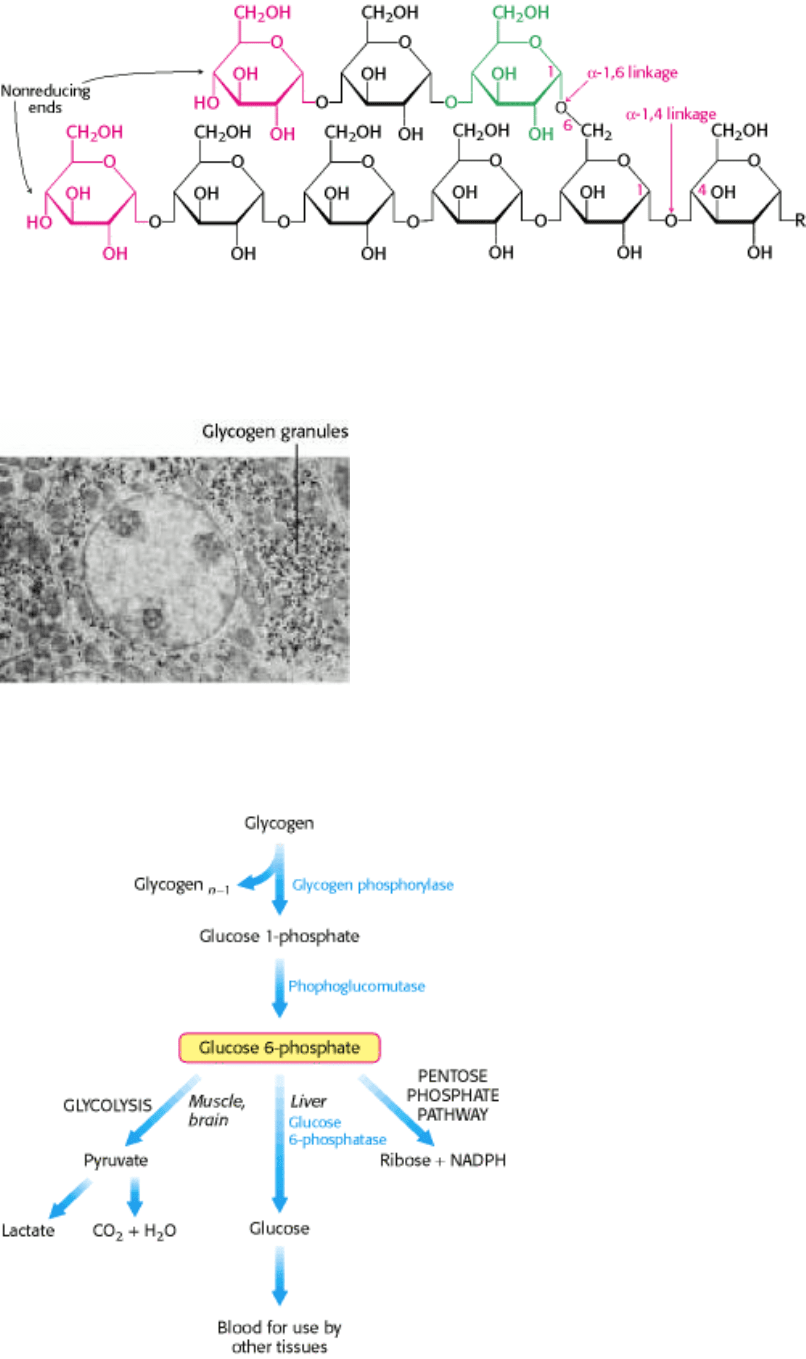
II. Transducing and Storing Energy 21. Glycogen Metabolism
Figure 21.1. Glycogen Structure. In this structure of two outer branches of a glycogen molecule, the residues at the
nonreducing ends are shown in red and residue that starts a branch is shown in green. The rest of the glycogen molecule
is represented by R.
II. Transducing and Storing Energy 21. Glycogen Metabolism
Figure 21.2. Electron Micrograph of a Liver Cell. The dense particles in the cytoplasm are glycogen granules.
[Courtesy of Dr. George Palade.]
II. Transducing and Storing Energy 21. Glycogen Metabolism
Figure 21.3. Fates of Glucose 6-Phosphate. Glucose 6-phosphate derived from glycogen can (1) be used as a fuel for
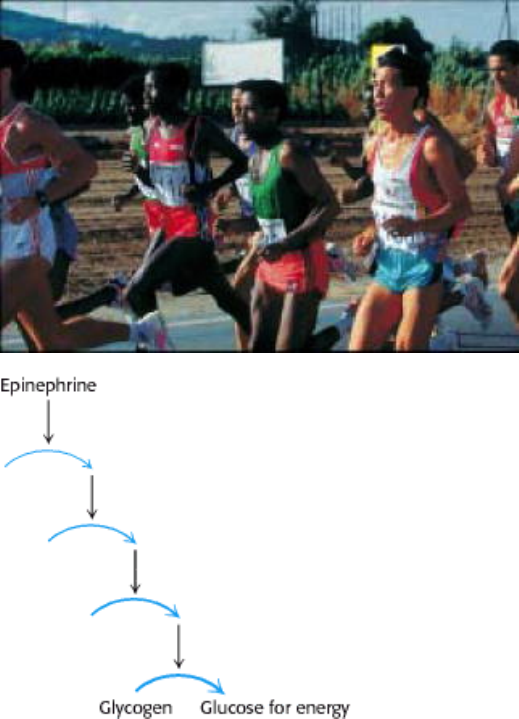
anaerobic or aerobic metabolism as in, for instance, muscle; (2) be converted into free glucose in the liver and
subsequently released into the blood; (3) be processed by the pentose phosphate pathway to generate NADPH or ribose
in a variety of tissues.
II. Transducing and Storing Energy 21. Glycogen Metabolism
Signal cascades lead to the mobilization of glycogen to produce glucose, an energy source for runners. [(Left) Mike
Powell/Allsport.]
II. Transducing and Storing Energy 21. Glycogen Metabolism
21.1. Glycogen Breakdown Requires the Interplay of Several Enzymes
The efficient breakdown of glycogen to provide glucose 6-phosphate for further metabolism requires four enzyme
activities: one to degrade glycogen, two to remodel glycogen so that it remains a substrate for degradation, and one to
convert the product of glycogen breakdown into a form suitable for further metabolism. We will examine each of these
activities in turn.
21.1.1. Phosphorylase Catalyzes the Phosphorolytic Cleavage of Glycogen to Release
Glucose 1-phosphate
Glycogen phosphorylase, the key enzyme in glycogen breakdown, cleaves its substrate by the addition of orthophosphate
(P
i
) to yield glucose 1-phosphate. The cleavage of a bond by the addition of orthophosphate is referred to as
phosphorolysis.
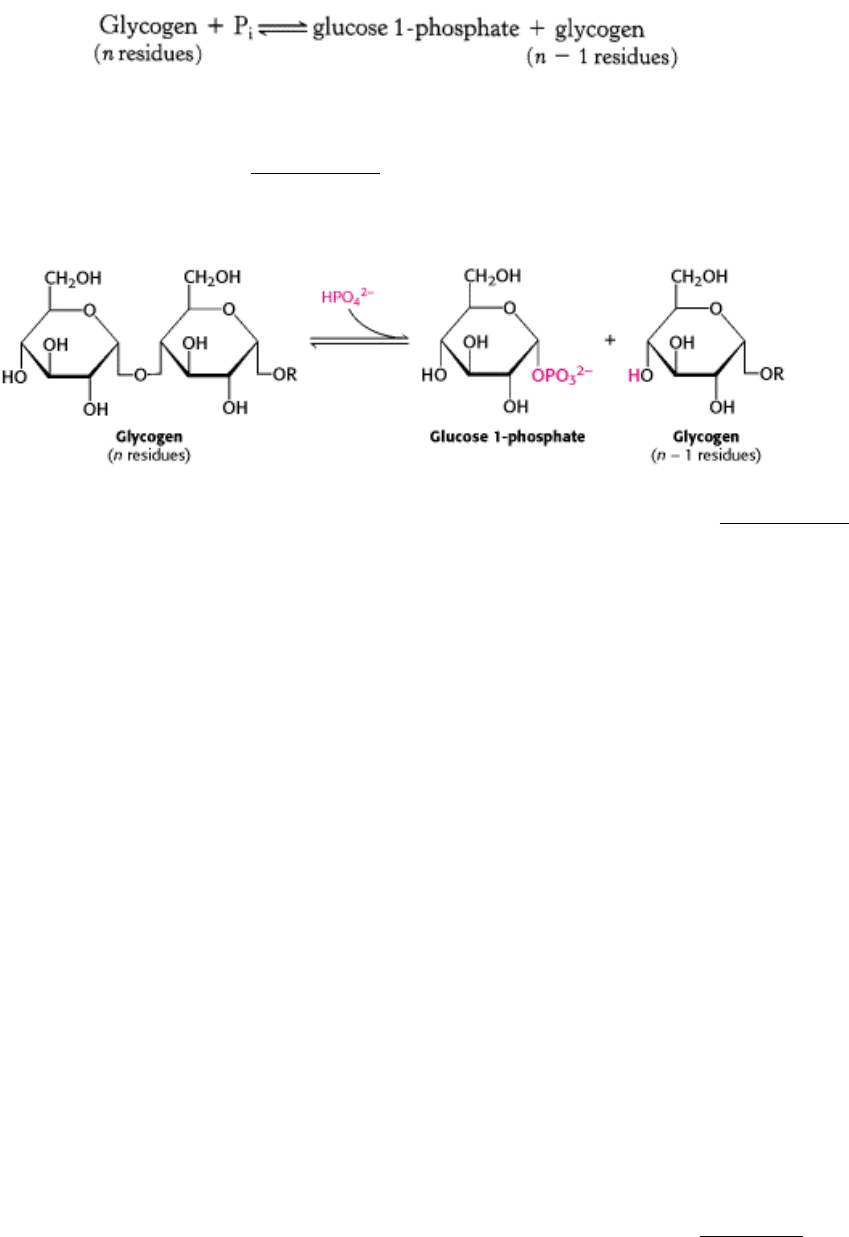
Phosphorylase catalyzes the sequential removal of glycosyl residues from the nonreducing ends of the glycogen
molecule (the ends with a free 4-OH groups; Section 11.1.3). Orthophosphate splits the glycosidic linkage between C-1
of the terminal residue and C-4 of the adjacent one. Specifically, it cleaves the bond between the C-1 carbon atom and
the glycosidic oxygen atom, and the α configuration at C-1 is retained.
Glucose 1-phosphate released from glycogen can be readily converted into glucose 6-phosphate (Section 21.1.3), an
important metabolic intermediate, by the enzyme phosphoglucomutase.
The reaction catalyzed by phosphorylase is readily reversible in vitro. At pH 6.8, the equilibrium ratio of orthophosphate
to glucose 1-phosphate is 3.6. The value of ∆ G°´ for this reaction is small because a glycosidic bond is replaced by a
phosphoryl ester bond that has a nearly equal transfer potential. However, phosphorolysis proceeds far in the direction of
glycogen breakdown in vivo because the [P
i
]/[glucose 1-phosphate] ratio is usually greater than 100, substantially
favoring phosphorolysis. We see here an example of how the cell can alter the free-energy change of a reaction to favor
the reaction's occurrence by altering the ratio of substrate and product.
The phosphorolytic cleavage of glycogen is energetically advantageous because the released sugar is already
phosphorylated. In contrast, a hydrolytic cleavage would yield glucose, which would then have to be phosphorylated at
the expense of the hydrolysis of a molecule of ATP to enter the glycolytic pathway. An additional advantage of
phosphorolytic cleavage for muscle cells is that glucose 1-phosphate, negatively charged under physiological conditions,
cannot diffuse out of the cell.
21.1.2. A Debranching Enzyme Also Is Needed for the Breakdown of Glycogen
Glycogen phosphorylase, the key enzyme in glycogen breakdown, can carry out this process by itself only to a limited
extent before encountering an obstacle. The α-1,6-glycosidic bonds at the branch points are not susceptible to cleavage
by phosphorylase. Indeed, phosphorylase stops cleaving α-1,4 linkages when it reaches a terminal residue four residues
away from a branch point. Because about 1 in 10 residues is branched, glycogen degradation by the phosphorylase alone
would come to a halt after the release of six glucose molecules per branch.
How can the remainder of the glycogen molecule be mobilized for use as a fuel? Two additional enzymes, a transferase
and α-1,6-glucosidase, remodel the glycogen for continued degradation by the phosphorylase (Figure 21.4). The
transferase shifts a block of three glycosyl residues from one outer branch to the other. This transfer exposes a single
glucose residue joined by an α-1,6-glycosidic linkage. α-1,6-Glucosidase, also known as the debranching enzyme,
hydrolyzes the α-1, 6-glycosidic bond, resulting in the release of a free glucose molecule.
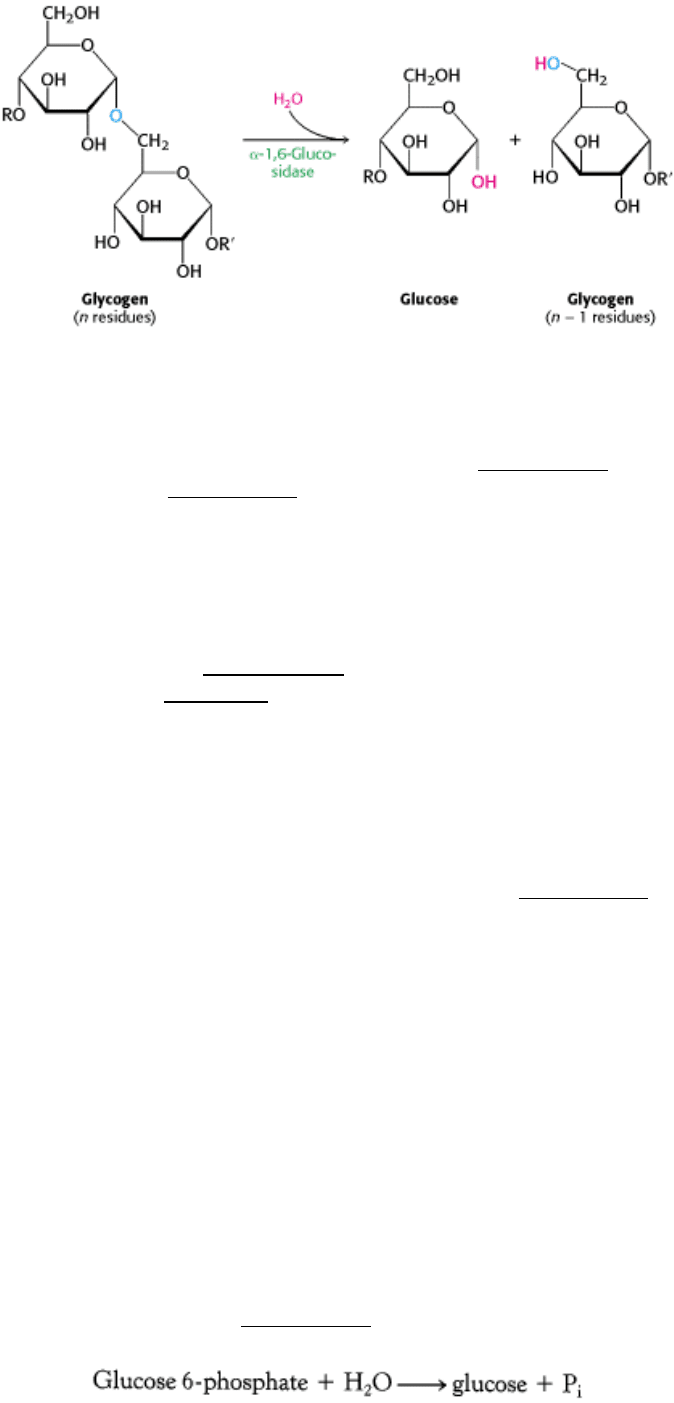
This free glucose molecule is phosphorylated by the glycolytic enzyme hexokinase. Thus, the transferase and α-1,6-
glucosidase convert the branched structure into a linear one, which paves the way for further cleavage by phosphorylase.
It is noteworthy that, in eukaryotes, the transferase and the α-1,6-glucosidase activities are present in a single 160-kd
polypeptide chain, providing yet another example of a bifunctional enzyme (Section 16.2.2). Furthermore, these enzymes
may have additional features in common (Section 21.4.3).
21.1.3. Phosphoglucomutase Converts Glucose 1-phosphate into Glucose 6-phosphate
Glucose 1-phosphate formed in the phosphorolytic cleavage of glycogen must be converted into glucose 6-phosphate to
enter the metabolic mainstream. This shift of a phosphoryl group is catalyzed by phosphoglucomutase. Recall that this
enzyme is also used in galactose metabolism (Section 16.1.11). To effect this shift, the enzyme engages in the exchange
of a phosphoryl group with the substrate (Figure 21.5).
The catalytic site of an active mutase molecule contains a phosphorylated serine residue. The phosphoryl group is
transferred from the serine residue to the C-6 hydroxyl group of glucose 1-phosphate to form glucose 1,6-bisphosphate.
The C-1 phosphoryl group of this intermediate is then shuttled to the same serine residue, resulting in the formation of
glucose 6-phosphate and the regeneration of the phosphoenzyme.
These reactions are like those of phosphoglycerate mutase, a glycolytic enzyme (Section 16.1.7). The role of glucose 1,6-
bisphosphate in the interconversion of the phosphoglucoses is like that of 2,3-bisphosphoglycerate (2,3-BPG) in the
interconversion of 2-phosphoglycerate and 3-phosphoglycerate in glycolysis. A phosphoenzyme intermediate
participates in both reactions.
21.1.4. Liver Contains Glucose 6-phosphatase, a Hydrolytic Enzyme Absent from
Muscle
A major function of the liver is to maintain a near constant level of glucose in the blood. The liver releases glucose into
the blood during muscular activity and between meals to be taken up primarily by the brain and skeletal muscle.
However, the phosphorylated glucose produced by glycogen breakdown, in contrast with glucose, is not readily
transported out of cells. The liver contains a hydrolytic enzyme, glucose 6-phosphatase, which cleaves the phosphoryl
group to form free glucose and orthophosphate. This glucose 6-phosphatase, located on the lumenal side of the smooth
endoplasmic reticulum membrane, is the same enzyme that releases free glucose at the conclusion of gluconeogenesis.
Recall that glucose 6-phosphate is transported into the endoplasmic reticulum; glucose and orthophosphate formed by
hydrolysis are then shuttled back into the cytosol (Section 16.3.5).
Glucose 6-phosphatase is absent from most other tissues. Consequently, glucose 6-phosphate is retained for the

generation of ATP. In contrast, glucose is not a major fuel for the liver.
21.1.5. Pyridoxal Phosphate Participates in the Phosphorolytic Cleavage of Glycogen
Let us now examine the catalytic mechanism of glycogen phosphorylase, which is a dimer of two identical 97-kd
subunits. Each subunit is compactly folded into an amino-terminal domain (480 residues) containing a glycogen-binding
site and a carboxyl-terminal domain (360 residues; Figure 21.6). The catalytic site is located in a deep crevice formed by
residues from amino- and carboxyl-terminal domains. The special challenge faced by phosphorylase is to cleave
glycogen phosphorolytically rather than hydrolytically to save the ATP required to phosphorylate free glucose. This
cleavage requires that water be excluded from the active site. Several clues provide us with information about the
mechanism by which phosphorylase achieves the exclusion of water. First, both the glycogen substrate and the glucose 1-
phosphate product have an α configuration at C-1 (the designation α means that the oxygen atom attached to C-1 is
below the plane of the ring; Section 11.1.3). A direct attack of phosphate on C-1 of a sugar would invert the
configuration at this carbon because the reaction would proceed through a pentacovalent transition state. Because the
resulting glucose 1-phosphate has an α rather than a β configuration, an even number of steps (most simply, two) is
required. The most likely explanation for these results is that a carbonium ion intermediate is formed.
A second clue to the catalytic mechanism of phosphorylase is its requirement for pyridoxal phosphate (PLP), a
derivative of pyridoxine (vitamin B
6
, Section 8.6.1). The aldehyde group of this coenzyme forms a Schiff base with a
specific lysine side chain of the enzyme (Figure 21.7). The results of structural studies indicate that the reacting
orthophosphate group takes a position between the 5
-phosphate group of PLP and the glycogen substrate (Figure 21.8).
The 5
-phosphate group of PLP acts in tandem with orthophosphate by serving as a proton donor and then as a proton
acceptor (that is, as a general acid-base catalyst). Orthophosphate (in the HPO
4
2-
form) donates a proton to the oxygen
atom attached to carbon 4 of the departing glycogen chain and simultaneously acquires a proton from PLP. The
carbonium ion intermediate formed in this step is then attacked by orthophosphate to form α-glucose 1-phosphate, with
the concomitant return of a hydrogen atom to pyridoxal phosphate. The requirement that water be excluded from the
active site calls for the special role of pyridoxal phosphate in facilitating the phosphorolytic cleavage.
The glycogen-binding site is 30 Å away from the catalytic site (see Figure 21.6), but it is connected to the catalytic site
by a narrow crevice able to accommodate four or five glucose units. The large separation between the binding site and
the catalytic site enables the enzyme to phosphorolyze many residues without having to dissociate and reassociate after
each catalytic cycle. An enzyme that can catalyze many reactions without having to dissociate and reassociate after each
catalytic step is said to be processive a property of enzymes that synthesize and degrade large polymers. We will see
such enzymes again when we consider DNA and RNA synthesis.
II. Transducing and Storing Energy 21. Glycogen Metabolism 21.1. Glycogen Breakdown Requires the Interplay of Several Enzymes
